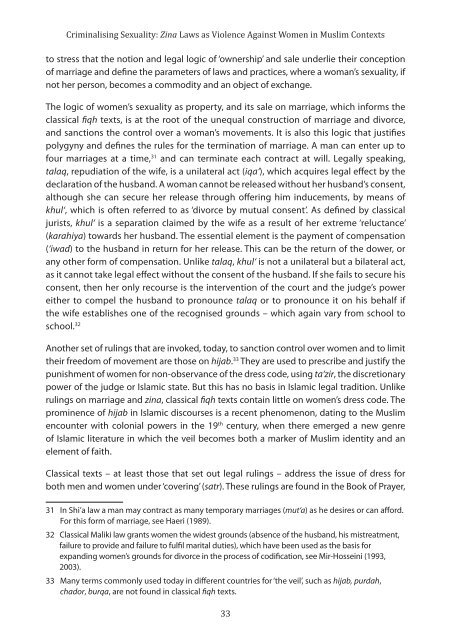control and sexuality
control and sexuality
control and sexuality
- No tags were found...
You also want an ePaper? Increase the reach of your titles
YUMPU automatically turns print PDFs into web optimized ePapers that Google loves.
Criminalising Sexuality: Zina Laws as Violence Against Women in Muslim Contextsto stress that the notion <strong>and</strong> legal logic of ‘ownership’ <strong>and</strong> sale underlie their conceptionof marriage <strong>and</strong> define the parameters of laws <strong>and</strong> practices, where a woman’s <strong>sexuality</strong>, ifnot her person, becomes a commodity <strong>and</strong> an object of exchange.The logic of women’s <strong>sexuality</strong> as property, <strong>and</strong> its sale on marriage, which informs theclassical fiqh texts, is at the root of the unequal construction of marriage <strong>and</strong> divorce,<strong>and</strong> sanctions the <strong>control</strong> over a woman’s movements. It is also this logic that justifiespolygyny <strong>and</strong> defines the rules for the termination of marriage. A man can enter up tofour marriages at a time, 31 <strong>and</strong> can terminate each contract at will. Legally speaking,talaq, repudiation of the wife, is a unilateral act (iqa‘), which acquires legal effect by thedeclaration of the husb<strong>and</strong>. A woman cannot be released without her husb<strong>and</strong>’s consent,although she can secure her release through offering him inducements, by means ofkhul‘, which is often referred to as ‘divorce by mutual consent’. As defined by classicaljurists, khul‘ is a separation claimed by the wife as a result of her extreme ‘reluctance’(karahiya) towards her husb<strong>and</strong>. The essential element is the payment of compensation(‘iwad) to the husb<strong>and</strong> in return for her release. This can be the return of the dower, orany other form of compensation. Unlike talaq, khul‘ is not a unilateral but a bilateral act,as it cannot take legal effect without the consent of the husb<strong>and</strong>. If she fails to secure hisconsent, then her only recourse is the intervention of the court <strong>and</strong> the judge’s powereither to compel the husb<strong>and</strong> to pronounce talaq or to pronounce it on his behalf ifthe wife establishes one of the recognised grounds – which again vary from school toschool. 32Another set of rulings that are invoked, today, to sanction <strong>control</strong> over women <strong>and</strong> to limittheir freedom of movement are those on hijab. 33 They are used to prescribe <strong>and</strong> justify thepunishment of women for non-observance of the dress code, using ta‘zir, the discretionarypower of the judge or Islamic state. But this has no basis in Islamic legal tradition. Unlikerulings on marriage <strong>and</strong> zina, classical fiqh texts contain little on women’s dress code. Theprominence of hijab in Islamic discourses is a recent phenomenon, dating to the Muslimencounter with colonial powers in the 19 th century, when there emerged a new genreof Islamic literature in which the veil becomes both a marker of Muslim identity <strong>and</strong> anelement of faith.Classical texts – at least those that set out legal rulings – address the issue of dress forboth men <strong>and</strong> women under ‘covering’ (satr). These rulings are found in the Book of Prayer,31 In Shi’a law a man may contract as many temporary marriages (mut‘a) as he desires or can afford.For this form of marriage, see Haeri (1989).32 Classical Maliki law grants women the widest grounds (absence of the husb<strong>and</strong>, his mistreatment,failure to provide <strong>and</strong> failure to fulfil marital duties), which have been used as the basis forexp<strong>and</strong>ing women’s grounds for divorce in the process of codification, see Mir-Hosseini (1993,2003).33 Many terms commonly used today in different countries for ‘the veil’, such as hijab, purdah,chador, burqa, are not found in classical fiqh texts.33


